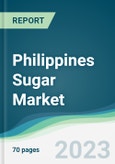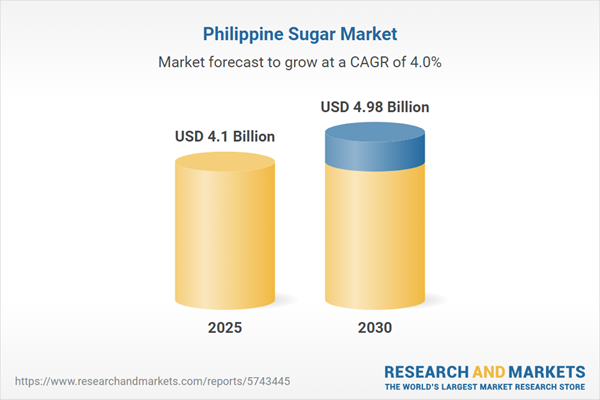The Philippines sugar market is expected to grow at a compound annual growth rate (CAGR) of 3.97% from US$ 4.10 billion in 2025 to US$ 4.98 billion in 2030.
The Philippines' sugar industry of today is considerably dissimilar from that of the past. The nation's economy continues to depend heavily on the sugar sector. The majority of the sugar industry's output is currently used to meet the local demands of Filipino producers and consumers. It primarily exports to the American market and seldom engages in exporting to the international sugar market. Western Visayas is the region that produces the most, followed by Northern Mindanao and Central Visayas. The major landowners, millers, distillers, and refineries are the key actors in the sugar sector. The largest sugar producer in the nation and one of the biggest sugar mills and refineries in Asia is Victoria's Milling in Negros Occidental. According to Victoria Milling (2019), it meets around 30% of the county's daily demand for refined sugar.
Sugarcane as a crop is currently grown in 17 provinces which are widely distributed in 8 regions from the northernmost island of Luzon to the southernmost island of Mindanao. Sugar trading and marketing have been too fragmented. The producers and cooperatives do not market and sellsugarcollectively. Although traders have played an important role as market distributors and in reaching the retail markets.
The raw sugar production had been 380,816 hectares in 2022-2023, 394,637 hectares in 2021-2022, and 399,166 hectares in 2020-2021, according to the Sugar Regulation Administration, Philippines. Low productivity is due to the El Niño and lack of irrigation facilities in some regions.
In recent years, the Philippine sugar sector has been severely tested by natural disasters such as typhoons and droughts, both of which are exacerbated by climate change. The production declined, with raw sugar output of only 1.8 million metric tonnes in fiscal year 2022/23. Consequently, raw and refined sugar prices have skyrocketed, causing inflationary pressure on consumer goods.
To stabilize supply and prices, the government has decided to import refined sugar while re-exporting raw sugar to fulfill its quota with the United States36. This twin strategy seems to balance domestic needs with international commitments but is likely to hurt the already battered local farmers who suffer from a combination of high cost of production and adverse weather conditions.
Stakeholders are looking forward to better infrastructural and irrigation facilities, which will enhance productivity. There is also a clamor for more integrated marketing strategies among producers to gain bargaining power over traders. The future of the industry depends on the solution of these systemic problems while adapting to changing environmental conditions.
The Philippines has a rapidly growing food & beverage (F&B) industry and one of the biggest contributors to the nation's economy, making up about half of its manufacturing sector. In 2022, revenue in the food market amounts to €113,009m in 2022. The overall food andbeverages market expansion will increase the demand for sugar in the sector. The country has significant sugarcane-producing regions. Western Visayas is the top sugarcane-producing region with 1.34 million metric tons or 47.2 percent share of the total production. This is followed by Northern Mindanao and Central Visayas, with corresponding production shares of 18.3% and 12.6%, respectively. These regions contributed 78.1 percent of the country's total sugarcane production.
The rapid proliferation of chain restaurants and meal delivery services adds to this need, as consumers seek different culinary experiences that frequently include sweetened beverages and sweets. Furthermore, the move towards health-conscious eating has resulted in a growing market for organic and natural sugar alternatives, compelling traditional sugar producers to improve their product offerings. This trend not only appeals to health-conscious customers but also creates new opportunities for growth in the sugar business.
This, therefore, motivates local producers to increase their production capacity and embrace sustainable practices to answer the domestic as well as international demand. The Philippine government is expected to support this change through policies promoting agricultural productivity and sustainability in the sugar industry. Overall, the interplay between a booming F&B sector and a solid sugar production framework positions the Philippines for tremendous growth in its sugar market over the coming years.
The Philippines' sugar industry of today is considerably dissimilar from that of the past. The nation's economy continues to depend heavily on the sugar sector. The majority of the sugar industry's output is currently used to meet the local demands of Filipino producers and consumers. It primarily exports to the American market and seldom engages in exporting to the international sugar market. Western Visayas is the region that produces the most, followed by Northern Mindanao and Central Visayas. The major landowners, millers, distillers, and refineries are the key actors in the sugar sector. The largest sugar producer in the nation and one of the biggest sugar mills and refineries in Asia is Victoria's Milling in Negros Occidental. According to Victoria Milling (2019), it meets around 30% of the county's daily demand for refined sugar.
Sugarcane as a crop is currently grown in 17 provinces which are widely distributed in 8 regions from the northernmost island of Luzon to the southernmost island of Mindanao. Sugar trading and marketing have been too fragmented. The producers and cooperatives do not market and sellsugarcollectively. Although traders have played an important role as market distributors and in reaching the retail markets.
The raw sugar production had been 380,816 hectares in 2022-2023, 394,637 hectares in 2021-2022, and 399,166 hectares in 2020-2021, according to the Sugar Regulation Administration, Philippines. Low productivity is due to the El Niño and lack of irrigation facilities in some regions.
In recent years, the Philippine sugar sector has been severely tested by natural disasters such as typhoons and droughts, both of which are exacerbated by climate change. The production declined, with raw sugar output of only 1.8 million metric tonnes in fiscal year 2022/23. Consequently, raw and refined sugar prices have skyrocketed, causing inflationary pressure on consumer goods.
To stabilize supply and prices, the government has decided to import refined sugar while re-exporting raw sugar to fulfill its quota with the United States36. This twin strategy seems to balance domestic needs with international commitments but is likely to hurt the already battered local farmers who suffer from a combination of high cost of production and adverse weather conditions.
Stakeholders are looking forward to better infrastructural and irrigation facilities, which will enhance productivity. There is also a clamor for more integrated marketing strategies among producers to gain bargaining power over traders. The future of the industry depends on the solution of these systemic problems while adapting to changing environmental conditions.
Philippines Sugar market drivers
Growing food and beverage sector is projected to propel the Philippines sugar market expansion.The Philippines has a rapidly growing food & beverage (F&B) industry and one of the biggest contributors to the nation's economy, making up about half of its manufacturing sector. In 2022, revenue in the food market amounts to €113,009m in 2022. The overall food andbeverages market expansion will increase the demand for sugar in the sector. The country has significant sugarcane-producing regions. Western Visayas is the top sugarcane-producing region with 1.34 million metric tons or 47.2 percent share of the total production. This is followed by Northern Mindanao and Central Visayas, with corresponding production shares of 18.3% and 12.6%, respectively. These regions contributed 78.1 percent of the country's total sugarcane production.
The rapid proliferation of chain restaurants and meal delivery services adds to this need, as consumers seek different culinary experiences that frequently include sweetened beverages and sweets. Furthermore, the move towards health-conscious eating has resulted in a growing market for organic and natural sugar alternatives, compelling traditional sugar producers to improve their product offerings. This trend not only appeals to health-conscious customers but also creates new opportunities for growth in the sugar business.
This, therefore, motivates local producers to increase their production capacity and embrace sustainable practices to answer the domestic as well as international demand. The Philippine government is expected to support this change through policies promoting agricultural productivity and sustainability in the sugar industry. Overall, the interplay between a booming F&B sector and a solid sugar production framework positions the Philippines for tremendous growth in its sugar market over the coming years.
Reasons for buying this report:
- Insightful Analysis: Gain detailed market insights covering major as well as emerging geographical regions, focusing on customer segments, government policies and socio-economic factors, consumer preferences, industry verticals, other sub-segments.
- Competitive Landscape: Understand the strategic maneuvers employed by key players globally to understand possible market penetration with the correct strategy.
- Market Drivers & Future Trends: Explore the dynamic factors and pivotal market trends and how they will shape up future market developments.
- Actionable Recommendations: Utilize the insights to exercise strategic decision to uncover new business streams and revenues in a dynamic environment.
- Caters to a Wide Audience: Beneficial and cost-effective for startups, research institutions, consultants, SMEs, and large enterprises.
What do businesses use our reports for?
Industry and Market Insights, Opportunity Assessment, Product Demand Forecasting, Market Entry Strategy, Geographical Expansion, Capital Investment Decisions, Regulatory Framework & Implications, New Product Development, Competitive IntelligenceReport Coverage:
- Historical data & forecasts from 2022 to 2030
- Growth Opportunities, Challenges, Supply Chain Outlook, Regulatory Framework, Customer Behaviour, and Trend Analysis
- Competitive Positioning, Strategies, and Market Share Analysis
- Revenue Growth and Forecast Assessment of segments and regions including countries
- Company Profiling (Strategies, Products, Financial Information, and Key Developments among others)
The Philippines Sugar market is analyzed into the following segments:
By Form
- Granulated
- Powdered
- Syrup
By Source
- Cane Sugar
- Beet Sugar
By Use
- Food And Beverage
- Pharmaceuticals
By Distribution Channel
- Online
- Offline
Table of Contents
1. INTRODUCTION
2. RESEARCH METHODOLOGY
3. EXECUTIVE SUMMARY
4. MARKET DYNAMICS
5. PHILIPPINES SUGAR MARKET BY FORM
6. PHILIPPINES SUGAR MARKET BY SOURCE
7. PHILIPPINES SUGAR MARKET BY USE
8. PHILIPPINES SUGAR MARKET BY DISTRIBUTION CHANNEL
9. COMPETITIVE ENVIRONMENT AND ANALYSIS
10. COMPANY PROFILES
Companies Mentioned
- Wilmar International Ltd.
- Crystal Sugar Company, Inc.
- Binalbagan-isabela Sugar Company Inc (Biscom)
- Central Azucarera De Tarlac
- Universal Robina Corp. (Carsumco)
- Hawaiian-philippine Company
- Raw Brown Sugar Milling Co., Inc.
- Victorias Milling Company
Methodology

LOADING...
Table Information
| Report Attribute | Details |
|---|---|
| No. of Pages | 70 |
| Published | December 2024 |
| Forecast Period | 2025 - 2030 |
| Estimated Market Value ( USD | $ 4.1 Billion |
| Forecasted Market Value ( USD | $ 4.98 Billion |
| Compound Annual Growth Rate | 3.9% |
| Regions Covered | Philippines |
| No. of Companies Mentioned | 8 |









